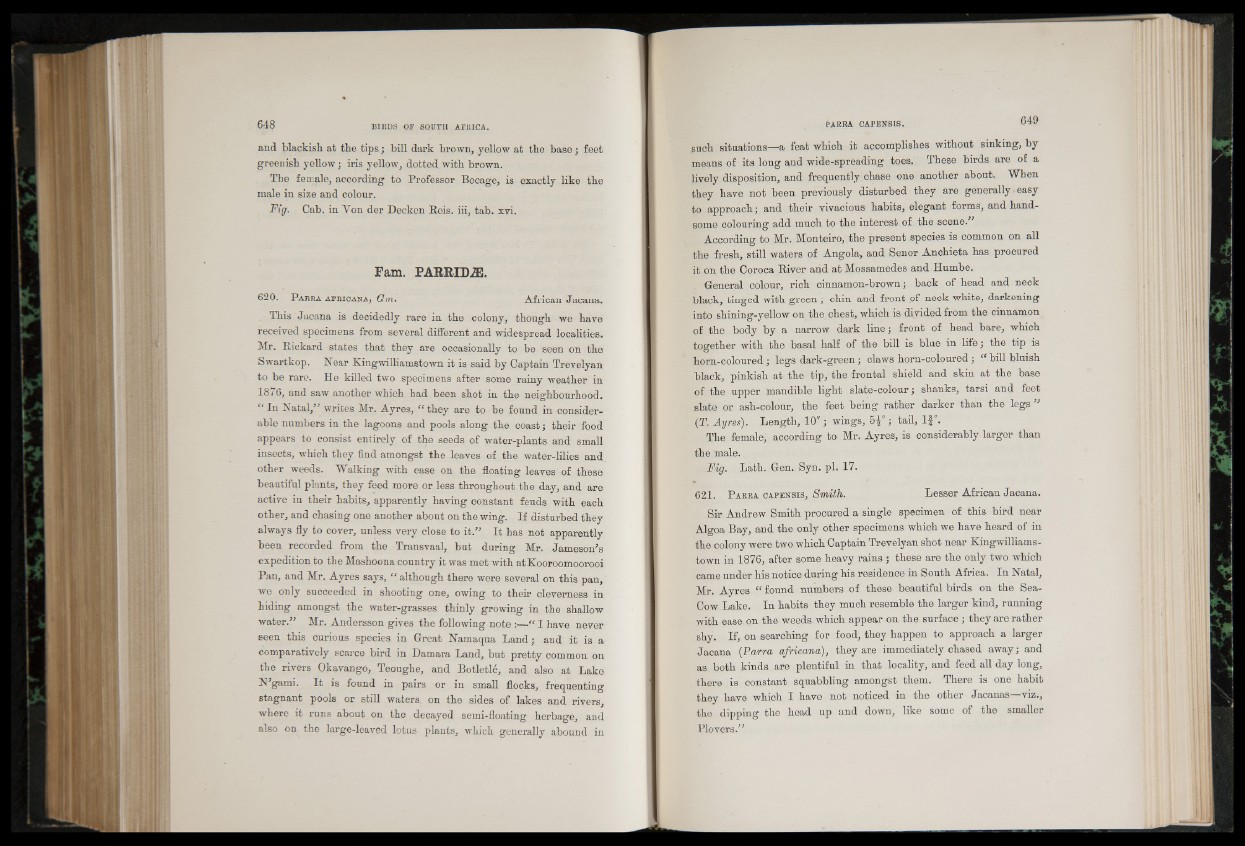
and blackish at the tips; bill dark brown, yellow at the base; feet
greenish yellow; iris yellow, dotted with brown.
The female, according to Professor Bocage, is exactly like the
male in size and colour.
Fig. Cab. in Yon der Decken Rois. iii, tab. xvi.
Fam. PARRIDiE.
620. P a r r a a f r i c a n a , Gm. African Jacana.
This Jacana is decidedly rare in the colony, though we have
received specimens from several different and widespread localities.
Mr. Rickard states that they are occasionally to be seen on the
Swartkop. Near Kingwilliamstown it is said by Captain Trevelyan
to be rare. He killed two specimens after some rainy weather in
1876, and saw another which had been shot in the neighbourhood.
“ In Natal,” writes Mr. Ayres, “ they are to be found in considerable
numbers in the lagoons and pools along the coast; their food
appears to consist entirely of the seeds of water-plants and small
insects, which they find amongst the leaves of the water-lilies and
other weeds. Walking with ease on the floating leaves of these
beautiful plants, they feed more or less throughout the day, and are
active in their habits, apparently having constant feuds with each
other, and chasing one another about on the wing. If disturbed they
always fly to cover, unless very close to it.” It has not apparently
been recorded from the Transvaal, but during Mr. Jameson’s
expedition to the Mashoona country it was met with atKooroomoorooi
Pan, and Mr. Ayres says, “ although there were several on this pan,
we only succeeded in shooting one, owing to their cleverness in
hiding amongst the water-grasses thinly growing in the shallow
water. Mr. Andersson gives the following note :—,cc I have never
seen this curious species in Great Namaqua Land; and it is a
comparatively scarce bird in Damara Land, but pretty common on
the rivers Okavango, Teoughe, and Botletlé, and also at Lake
N garni. It is found in pairs or in small flocks, frequenting
stagnant pools or still waters, on the sides of lakes and rivers,
where it runs about on the decayed semi-floating herbage, and
also on the large-leaved lotus plants, which generally abound in
such situations—a feat which it accomplishes without sinking, by
means of its long and wide-spreading toes. These birds are of a
lively disposition, and frequently chase one another about. When
they have not been previously disturbed they are generally easy
to approach; and their vivacious habits, elegant forms, and handsome
colouring add much to the interest of the scene.
According to Mr. Monteiro, the present species is common on all
the fresh, still waters of Angola, and Senor Anchieta has procured
it on the Ooroca River arid at Mossamedes and Humbe.
General colour, rich cinnamon-brown; back of head and neck
black, tinged with green; chin and front of neck white, darkening
into shining-yellow on the chest, which is divided from the cinnamon
of the body by a narrow dark line; front of head bare, which
together with the basal half of the bill is blue in life; the tip is
horn-coloured; legs dark-green; claws horn-coloured ; “ bill bluish
black, pinkish at the tip, the frontal shield and skin at the base
of the upper mandible light slate-colour; shanks, tarsi and feet
slate or ash-colour, the feet being rather darker than the legs”
(T. Ayres). Length, 10"; wings, 5 |" ; tail, If".
The female, according to Mr. Ayres, is considerably larger than
the male.
Fig. Lath. Gen. Syn. pi. 17.
621. P a r r a c a p e n s i s , Smith. Lesser African Jacana.
Sir Andrew Smith procured a single specimen of this bird near
Algoa Bay, and the only other specimens which we have heard of in
the colony were two which Captain Trevelyan shot near Kingwilliams-
town m 1876, after some heavy rams ; these are the only two which
came under his notice during his residence in South Africa. In Natal,
Mr. Ayres “ found numbers of these beautiful birds on the Sea-
Cow Lake. In habits they much resemble the larger kind, running
with ease on the weeds which appear on the surface; they are rather
shy. If, on searching for food, they happen to approach a larger
Jacana (Parra africana), they are immediately chased away; and
as both kinds are plentiful in that locality, and feed all day long,
there is constant squabbling amongst them. There is one habit
they have which I have not noticed in the other Jacanas viz.,
the dipping the head up and down, like some of the smaller
Plovers.”